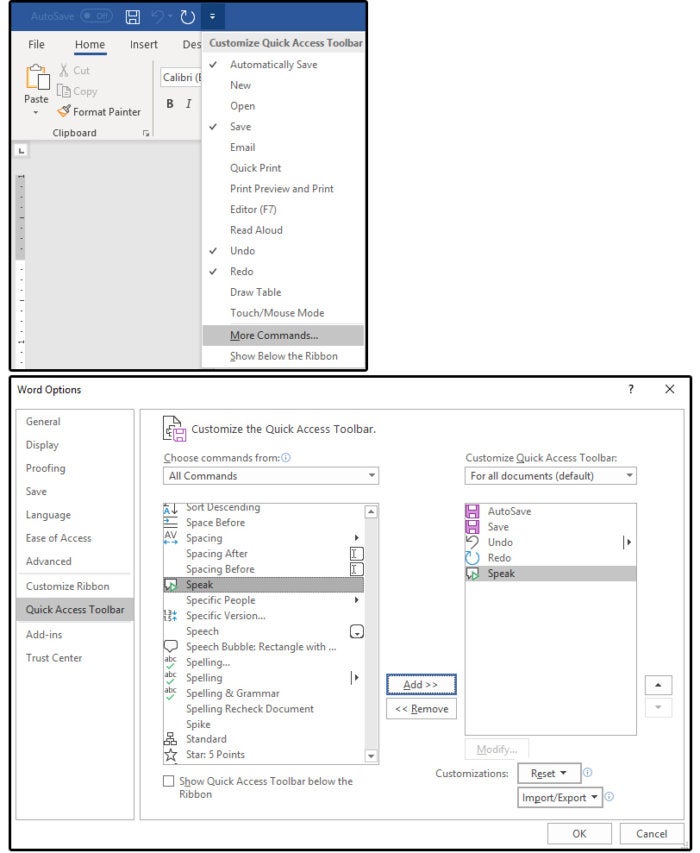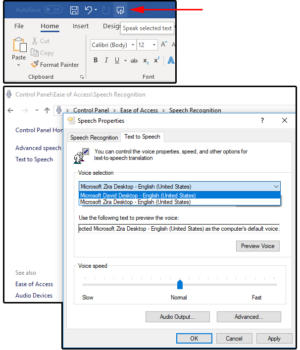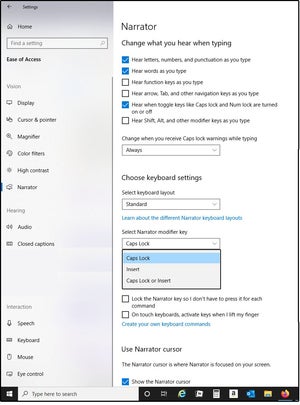Microsoft Feature That Read Text Out Loud
Can Microsoft Word read to me? Aye, it can. There are 3 ways to accomplish this task: The Speak and Read Aloud features in Word, or the Narrator feature in Windows.
The Speak feature was incorporated into Microsoft Office (Discussion, Outlook, PowerPoint, etc.) back in version 2003. It was called Text to Speech (TTS) and so, and information technology functioned much the aforementioned as it does now. Fortunately, information technology's a very simple procedure to set upwardly and use, so you can get started immediately.
1. Click the Customize arrow on the Quick Admission Toolbar.
ii. From the dropdown bill of fare, select More Commands.
3. Go toWord Options >Customize the Quick Access Toolbar and locate the Choose Commands From box. Whorl down to the Speak command.
four. Select the Speak command, click the Add push in the middle of the screen, so click OK.
5. Give-and-take adds the Speak command to the Quick Access Toolbar at the end, and you're set up to go.
 JD Sartain / IDG Worldwide
JD Sartain / IDG Worldwide Add Speak button to Quick Access Toolbar
Click the Speak push button to listen to your text
1. Ensure that your system's speakers or sound devices are turned on.
two. Highlight a paragraph of text, then click the Speak command button.
iii. Word reads whatsoever text that's highlighted, even the entire document. Press Ctrl+ A to select the entire document.
4. Click the Speak command button once to begin the reading session, so click it once more to stop. There is no suspension-and-keep option at this time, only many users have requested this feature, and so we hope to see information technology in futurity versions.
Select the Read Aloud command
1. Another style to have your text read aloud in Word is to select the Review tab > Read Aloud button.
The greatest benefit of Read Aloud as opposed to the Speak command is…
(a) You don't have to highlight the text. Just position your cursor where you lot desire the reading aloud to begin and click the Read Aloud button.
And (b), when y'all click the Read Aloud push a 2d time, it stops. Click the button again to continue from that bespeak on. So, essentially, y'all have a Pause characteristic with Read Aloud that is not available with Speak.
Change the Speak preferences in the Windows Control Console
The Speak preferences are defined in Widows, non in Word specifically.
1. Click Start > Windows Arrangement > Control Panel
2. Select Ease of Admission > Oral communication Recognition > Text to Speech, and the Speech Properties dialog window opens on the Text to Speech tab.
 JD Sartain / IDG Worldwide
JD Sartain / IDG Worldwide 3. Under Voice Option, choose MS David Desktop for a male phonation or MS Zira Desktop for a female vocalism.
4. Click the Preview push button to listen to each vocalism, then make your option.
5. Use the slider under Voice Speed to adapt the stride (ho-hum, normal, or fast) of the reader.
vi. Click the Audio Output push to define the Sound preferences.
7. Click the Advanced button to select or change the output device.
Using Windows 10 Narrator in Give-and-take and beyond
Windows 10 Narrator is an accessibility feature designed for vision-dumb users, however, anyone can use it. It reads everything onscreen: documents, websites, comments, page instructions, commands, and more. It's too not restricted to Give-and-take, as the Speak feature is.
Using Narrator is really easy, though learning all the commands may take some time. See Microsoft'due south "Complete guide to Windows Narrator" for full information. (If you search elsewhere online for WIndows ten Narrator assistance, check the date of the article and the Windows version earlier you get-go memorizing commands.)
At that place are two keyboard layouts available: Standard and Legacy. The default is Standard. Follow these instructions to alter the keyboard (which changes how the commands office). For more data, go to Microsoft's back up page about Narrator keyboard layouts.
one. Right-click the Windows Start button and select Settings.
2. Select Ease of Access.
3. Click Narrator in the left panel.
4. Browse to Choose Keyboard Setting.
5. From the Select Keyboard Layout field box, choose Standard or Legacy.
six. Next, select your Narrator Modifier key (that is the key used to activate the Narrator commands). Options include Caps Lock, Insert, or Caps Lock and Insert. I chose the Caps Lock key, because its location on the keyboard is more than efficient.
vii. Once y'all have chosen the Narrator Modifier key, the instructions here and on the web will refer to that key as the Narrator key (or, in some cases, the SR fundamental).
eight. Exit the Settings card.
 JD Sartain / IDG
JD Sartain / IDG Windows Narrator keyboard settings.
The basics for using Narrator are this:
1. Printing Windows logo key + Ctrl +Enter (simultaneously) to access or exit Narrator.
2. If y'all have not memorized all the "reader" keystrokes yet, the easiest method to read text is to place your cursor on the target word/sentence/paragraph and press Narrator key + Downwardly Pointer. Press Narrator fundamental (past itself) to finish, then Narrator fundamental + Downwards Pointer to go on. In that location are other keys that perform this same function, simply these are the easiest.
three. Most important: For a list of all the Narrator commands, press Narrator + F1.
4. For reading the electric current paragraph, printing Narrator + Ctrl + Chiliad.
5. For the adjacent paragraph, printing Narrator + Ctrl + L.
6. For the electric current page, press Narrator + Ctrl + I.
seven. For the next page, press Narrator + Ctrl + O.
The list goes on and on. In addition to the complete guide above, bank check out the support pages for Windows 10 Narrator keyboard commands and touch gestures, and Windows 10 narrator reading text.
Source: https://www.pcworld.com/article/403212/microsoft-word-reads-to-you-how-to-use-the-speak-and-read-aloud-commands.html
0 Response to "Microsoft Feature That Read Text Out Loud"
Post a Comment